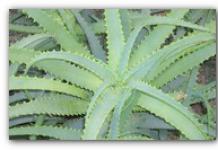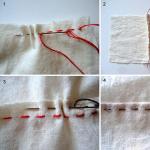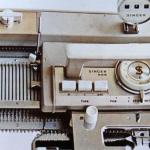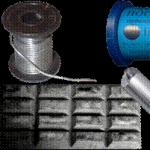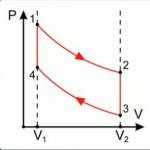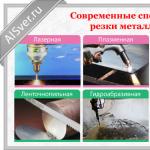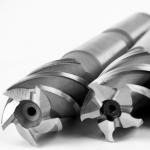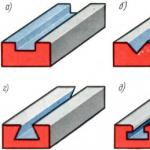The quality of the work performed depends on the correct choice of cutting modes when processing metal products on milling machines. For this reason, the analytical calculation of such regimes should be carried out as competently and efficiently as possible.
1
In milling, the processing of parts is inherently much more difficult than in turning. This is due to the fact that any tooth of the milling tool with each revolution of the cutter first enters and then leaves contact with the workpiece. Moreover, the process of its entry into contact is accompanied by a blow of a sufficiently tangible force. In addition, intermittent chips are removed from the part during milling, the thickness of which is not constant (when turning, the chip cross section always has the same indicator).
For these reasons, the operator must be very responsible in calculating cutting conditions in order to achieve maximum productivity of the milling unit under the most favorable conditions for its operation, taking into account the power of the equipment.
Milling part
Under such conditions, cutting conditions are understood that provide the optimal combination of feed during milling, the speed and force of the process, the depth of the cut metal layer in order to obtain the specified purity and accuracy of processing at minimal cost.
Every metalworking company has standard codes that provide clear guidelines that make it easier to choose the cutting option for various workpieces. With their help, you can develop operational maps and directly the technological process, which includes all the elements of milling. But many of the parameters specified in such standards are not suitable for cases where new equipment and modern cutting tools are used. In such situations, the operator has to independently calculate the processing modes. Next, we describe their main elements.
2
The material from which the cutter is made directly affects the possibilities and quality of cutting operations. Milling cutters and cutters with hard alloy plates are recognized as the most effective tools. They are currently used for most milling operations, but on condition that the technical potential of the machines (their engine power indicator, spindle speed, and so on) allows you to work with such devices.

HSS cutters
Some units of older models simply cannot use carbide and high-speed tools. Then they work with conventional end and other cutters. If the product after milling must have high accuracy and surface finish, and at the same time the speed of the procedure is not of great importance, it is better to use fixtures from conventional alloyed and.
The geometry of the cutting part of the tool also affects the choice of a specific mode of processing the part. The shape and dimensions that the cutter tooth has, its rear and front corners, the parameters of the transitional edge and corners are selected from special tables. They provide information about what dimensions the tooth must have and all the indicated angles when working with workpieces made of various materials (alloyed, heat-resistant, carbon steels, copper-based alloys, cast iron). When using a high-speed tool, all the necessary parameters are taken from another table.

Different types of tools
Modern factories for the production of cutters in most cases supply them with clearly marked geometric dimensions, which are specified in the relevant State Standards. The miller cannot change the geometry of such a tool in any way, so he needs to correctly select the device he needs (for example, a face mill) from the set of available working devices. In this case, an experienced specialist does not have any special problems, since he can use the tables with the recommended geometric values of the milling tool.
3
For rational milling of any products, these parameters are of great importance. Depth (in other words, the thickness of the cut layer) is the distance between the processed and processed surfaces. The size of the cut layer is usually selected as large as possible, always trying to make only one pass of the tool in order to obtain the desired milling result.
If the surface of the finished part must have increased purity and accuracy, the operation should be carried out in two passes - roughing, and then finishing. Sometimes the size of the cut layer is high and even two passes do not allow the operation to be performed qualitatively. In this case, the required depth is achieved by making two roughing passes.

Making a rough pass
In addition, it is not always possible to achieve the desired thickness of the cut layer in one pass on old milling units. Their strength (the power of electrical equipment) is simply not enough. In such situations, it is also recommended to do two draft procedures. Milling width refers to the width of the workpiece. If several parts are milled on the machine at once, which are mounted parallel to each other in the clamping mechanism, their total width is taken into account.
The operator learns the size of the workpieces from the working drawing attached to each product that he needs to process. Width and depth, as milling elements, are determined quite easily even by inexperienced workers. But here it is worth remembering that the indicator of the cut layer when working with castings and forgings made of steel and cast iron, on the surface of which there are impurities, foundry peel or scale, is taken more than the value of the contaminated layer.
If you do not heed this advice, the tooth of the tool will slide over the contaminated surface and leave defects in the form of black spots on it. The required indicator of the cut layer will be achieved in this case, but the cutting edge of the cutter will quickly become unusable. Yes, and the cost of force (power) equipment will require significant.

Cutting off the contaminated layer
- 0.5–1 mm - finishing;
- 5–7 mm - roughing for iron and steel casting;
- 3-5 mm - rough milling of parts from steels of different grades.
Compliance with these indicators of the cut layer usually guarantees high quality processing of workpieces on machines of any power.
4
The index of the cut layer, as well as the width of the processing, determine the choice of the diameter of the working device. The cutter section for cutting is selected according to three tables for different types of tools:
- disk;
- end;
- cylindrical.
The productivity of milling depends on the correct selection of the cutter section, since the diameter of the tool affects the size of the cut. It will be with an identical depth of milling and the feed of the device, the smaller the larger the cross section of the cutter. When calculating processing modes, this must always be taken into account.

Cutter diameter selection
Note that it is easier for the machine operator to work with thick slices (the smaller the depth of cut, the higher the specific pressure, which means that more power must be expended for processing). For this reason, whenever possible, he should select a cutter with a minimum diameter. The cross section of the working tool also affects the distance that the cutter overcomes in one pass. This indicator is called the path length. The formula for its calculation takes into account the overrun and plunge of the tool, as well as the length of the workpiece itself.
The overrun indicator is most often equal to 2-5 millimeters. In order to reduce the idle speed of the milling unit (in fact, to reduce the amount of overrun), it is necessary to take cutters of small section. The calculation of the infeed rate is carried out according to a formula that takes into account the depth of processing of the part on a specific machine of a certain power. For most milling cutters of any type, the preset values for the plunge path are given in the tables. It is easy to find these elements in them.

Small section tool
Another quantity that is affected by the cross section of the tool is the torque of a certain force. The spindle of the unit should be given a smaller moment with a small diameter of the cutter, increasing it with an increase in the cross section of the cutting device.
With all that said, it might seem that it is best to choose a cutter with a small section. But it's not. The problem is as follows: with a decrease in the diameter of the tool, it is necessary to select a mandrel with low rigidity for it (since the cutter will be thin). And this leads to the need to reduce the amount of chips cut from the part, that is, to the need to reduce the pressure forces on the mandrel. In this case, the efficiency of the milling mode, as you understand, is reduced.
5
In fine milling, the feed depends on how clean the machined surface of the product should be, in rough milling it depends on the following factors:
- indicator of rigidity of the scheme "detail/cutter/machine";
- the material from which the part is made;
- sharpening angles of the working tool;
- the power (force) of the drive of the milling unit;
- cutting tool material.

Feed selection for surface treatment
The main initial indicator by which the choice of feed for roughing is performed is the value of S (tooth). It depends on the mounting option (in relation to the part to be machined) of the cutting tool, which determines:
- chip thickness;
- angle parameter at which the tooth begins to interact with the workpiece;
- the angle at which the cutter tooth exits the part after it has been machined.

Cutter elements
The indicator S (tooth), as well as other elements of the milling of metal blanks, is important for the correct calculation of cutting conditions. Nobody calculates it manually. Usually they use standard tables compiled for different types of working tools.
Feed selection during finishing is also made according to tabular data. There is one nuance here. There is a very small amount of feed for each tooth of the tool during finishing. Therefore, the tables give values for a full revolution of the tool, and not for one of its teeth.
6
The milling speed is determined according to special standards, which include many cards for different types of cutters and processed materials (for steel, aluminum, etc.). Such maps take into account the power of machines and their other technical indicators. Selecting the desired processing speed due to this is quite simple.
Please note that standard tables for setting speed contain information for milling conditions with one tool at a certain level of cutter life. If the tool life differs from the tabular standard indicator, the calculation of the speed is carried out taking into account the correction factors. The latter were created on the basis of the following data:
- for end tool - processing width;
- properties (mechanical) of the workpiece to be milled;
- the value of the main angle of the cutter in the plan;
- the absence or presence of scale on the part.

Table for calculating cutting speed
In the described standards for determining the speed, such elements are indicated - the minute feed and the number of revolutions. The kinematics, force indicators and technical capabilities of the spindle of a particular milling equipment often differ from tabular data. In such situations, the worker, at his discretion, selects the rational speed of the machine. At the same time, he is obliged to make a choice in such a way that the cutter does not dull prematurely.
Separately, we note that when milling aluminum blanks, it is recommended to assign high-speed processing modes. They provide a large depth of cut at a low cost of electrical equipment power. If you work with aluminum parts at slow speeds, the risk of cutter failure increases, due to the fact that the resulting soft chips completely clog the tool grooves.
One of the ways to finish materials is milling. It is used for processing metal and non-metal workpieces. The workflow is controlled by cutting modes.
The essence of the process
Milling is carried out for the purpose of deep roughing and finishing, the formation of a certain surface profile (grooves, grooves), cutting teeth on gears, correcting the shape, artistic turning patterns and inscriptions.
The working tool - a cutter - makes the main rotating movement. Auxiliary is the translational feed of the workpiece relative to its course. This process is intermittent. Its most important feature, which distinguishes it from turning and drilling, is the fact that each tooth works separately. In this regard, it is characterized by the presence of shock loads. It is possible to reduce their influence taking into account a rational assessment of the situation and the selection of regimes.
Basic concepts about the operation of milling machines
Depending on the way the spindle is located and the cutter is fastened in it, on the types of actions performed and on the control methods, the main types of milling equipment are distinguished:
- horizontal;
- vertical;
- universal;
- CNC milling machines.
The main components of the vertical milling machine:
- A bed that houses a gearbox that regulates the rotation of a vertically mounted spindle and a cutter mounted on it.
- A table that includes a console with transverse skids for fastening and moving the workpiece and a feed box that regulates feed movements.
In horizontal milling machines, the tool is fixed horizontally. And universal have several varieties.
There is universal horizontal equipment, which is characterized by the presence of a turnover table and, thereby, expanding the range of possible work performed. In addition, there is a wide-universal one, which has both spindles in its structure and allows you to carry out all types of milling.
CNC machines are distinguished by the presence of software and computer control. They are designed for artistic processing of workpieces, including those in 3D format.

Milling cutter classification
Milling cutters are cutting tools. The main physical parameters by which they are evaluated are: height, diameter, chamfer and relief values, circumferential step. There is a huge variety of them, distributed according to various criteria:
- by the type of surfaces that are processed (for wood, plastic, steel, non-ferrous metals, etc.);
- in the direction of movement of rotation - right-cutting and left-cutting;
- depending on the design features - solid, soldered, folding (they have plug-in knives), welded;
- in shape: conical, cylindrical, disk;
- depending on the working conditions and requirements for the cutting part, they can be made of various materials. These include: carbon tool and high-speed steel (alloyed, with a high content of tungsten), hard alloy (durable - for roughing, wear-resistant - for finishing). Variants are common when the body is made of carbon or high-speed steel, and the knives are plug-in carbide;
- depending on the purpose: cylindrical, end, end, slotted, cutting, shaped.
The most informative features: cutting edge material and purpose.

Types of cutters for flat surfaces
In order to remove layers of material on horizontal, vertical or inclined planes, cylindrical and end mills are used.
The tool of the first type can be solid or with attached knives. Large solid milling tips are designed for roughing, and small ones are for finishing. Insert knives for folding cutting heads can be made of high speed steel or equipped with tungsten carbide blades. Carbide cutters are more productive than those made from alloy steel.
End is used for elongated planes, its teeth are distributed on the end surface. Large folding ones are used for wide planes. By the way, to remove chips from difficult-to-machine refractory metals, the presence of carbide knives is mandatory. To use these groups of milling devices, a significant width and length of the product is required.

Types of tools for artistic milling
To give the material a certain profile, apply a pattern, form narrow recesses, end and disk milling nozzles are used.
End or common for cutting grooves, narrow and curved planes. All of them are solid or welded, the cutting part is made of high speed alloy steel, hardfacing can be applied, and the body is made of carbon steel. There are low-start (1-3 spirals) and multi-start (4 or more). Used for CNC machines.
Disk is also a groove cutter. It is applicable for grooving, grooving, cutting teeth on gears.
Artistic milling is carried out on wood, metal, PVC.

Types of cutters for edge processing
Removing chips from corners, giving them a rational shape, modeling, dividing the workpiece into parts can be implemented using slotted, angled and shaped milling nozzles:
- Cut-off and slotted has the same purpose as the disk, however, they are more often used for incisions and separating excess parts of the material.
- Corner is needed for the edges of parts and corners. There are single-angle (only one cutting part) and two-angle (both conical surfaces are cutting).
- Shaped is used for complex structures. May be semicircular or concave. Often used for profile cutting of taps, countersinks,
For almost all types, a one-piece steel construction or folding, with the presence of plug-in carbide knives, is possible. Carbide cutters have qualitatively higher performance and duration for the tool as a whole.

Classification of types of milling
There are several classification features by which the types of milling are divided:
- according to the way the spindle and cutter are located, respectively, on the horizontal and vertical;
- in the direction of movement, on the opposite and passing;
- depending on the tool used, into cylindrical, end, shaped, end.
Cylindrical processing is applicable for horizontal planes, carried out using appropriate milling cutters on horizontal machines.
End finishing ensures the formation of the required profile for curved grooves, drills and devices.
Shaping is carried out for surfaces with a complex configuration: corners, edges, grooves, cutting teeth for gears.
Regardless of the type of work performed and the materials being processed, the result should be distinguished by a high smoothness of the finish layer, the absence of notches, and the accuracy of the finish. In order to obtain a clean machined surface, it is important to control the feed rates of the workpiece in relation to the tool.

Up and down milling
When counter-type metal is milled, the workpiece is fed against the rotational movements of the nozzle. In this case, the teeth gradually cut into the metal being processed, the load increases in direct proportion and evenly. However, before the tooth cuts into the part, it slides for some time, forming hardening. This phenomenon accelerates the exit of the cutter from the working state. Used for roughing.
When performing a passing type - the workpiece is fed in the course of the rotational movements of the tool. The teeth work shock under large teeth 10% lower than with up-cutting. It is carried out during the finishing of parts.
The basic concept of milling work on CNC machines
They are characterized by a high degree of automation, work process accuracy, high productivity. Milling on a CNC machine is most often carried out using face or end mills.
The latter are the most widely used. In this case, depending on the material being processed, the corresponding type of chip forming, the specified software parameters, different end mills are used. They are classified by the number of helix starts that provide cutting edges and ditching.
Materials with wide chips are best milled with tools with a small number of starts. For hard metals with characteristic fracture chips, it is necessary to choose milling fixtures with a large number of spirals.

Using cutters for CNC machines
Small lead milling cutters for CNC can have from one to three cutting edges. They are used for wood, plastics, composites and soft ductile metals requiring fast wide chip removal. They are used for roughing workpieces, which are not subject to high requirements. This tool is characterized by low productivity, low rigidity.
With the help of single-thread, artistic milling of aluminum is carried out.
Widely used are two- and three-way trailers. They provide higher rigidity values, high-quality chip removal, allow you to work with medium-hard metals (for example, steel).
Multi-thread cutters for CNC have more than 4 cutting edges. They are used for metals of medium and high hardness, which are characterized by small chips and high resistance. They are characterized by significant productivity, they are relevant for finishing and semi-finishing and are not designed to work with soft materials.
In order to choose the right tool for CNC machines, it is important to consider the cutting mode during milling, as well as all the characteristics of the surface to be machined.

Cutting conditions
To ensure the desired quality of the milled layer, it is important to correctly determine and maintain the necessary technical parameters. The main indicators that describe and regulate the milling process are operating modes.
The calculation during milling is made taking into account the main elements:
- Depth (t, mm) - the thickness of the metal ball, which is removed in one working move. Choose it taking into account the allowance for processing. Draft work is carried out in one pass. If the allowance is more than 5 mm, then milling is carried out in several passes, while leaving about 1 mm for the last one.
- Width (B, mm) - the width of the machined surface in the direction perpendicular to the feed movement.
- Feed (S) - the length of the workpiece movement relative to the tool axis.
There are several interrelated concepts:
- Feed per tooth (S z, mm / tooth) - change in the position of the part when turning the cutter at a distance from one working tooth to the next.
- Feed per revolution (S about, mm / about) - movement of the structure with one full revolution of the milling nozzle.
- Feed per minute (S min, mm/min) is an important cutting mode in milling.
Their relationship is established mathematically:
S min \u003d S about * n \u003d S z * z * n,
Where z- number of teeth;
n- spindle speed, min -1.
The amount of feed is also affected by the physical and technological properties of the treated area, the strength of the tool and the performance of the feed mechanism.
Cutting speed calculation
The degree of fast spindle rotation is taken as the nominal design parameter. The actual speed V, m/min depends on the diameter of the cutter and the frequency of its rotating movements:
The rotational speed of the milling tool is determined by:
n=(1000*V)/(π*D)
Having information about the minute feed, you can determine the required time for a workpiece with a length L:
The calculation of cutting conditions during milling and their installation is important to carry out before setting up the machine. The establishment of rational preset parameters, taking into account the characteristics of the tool and the material of the part, ensures high productivity.

It is impossible to choose the ideal cutting mode when milling, but you can be guided by the basic principles:
- It is desirable that the diameter of the cutter correspond to the depth of processing. This will ensure that the surface is cleaned in one pass. Here the main factor is the material. For too soft, this principle does not work - there is a risk of chip removal, thicker than necessary.
- Shock processes and vibrations are inevitable. Therefore, an increase in feed rates leads to a decrease in speed. It is optimal to start work with a feed per tooth equal to 0.15 mm / tooth, and adjust in the process.
- The rotational speed of the tool should not be as high as possible. Otherwise, there is a risk of reducing the cutting speed. Its increase is possible with an increase in the diameter of the cutter.
- The increase in the length of the working part of the cutter, the preference for a large number of teeth reduce productivity and quality of processing.
- Approximate speed values for various materials:
- aluminum - 200-400 m/min;
- bronze - 90-150 m/min;
- stainless steel - 50-100 m/min;
- plastics - 100-200 m/min.
It is better to start with an average speed, and in the process adjust it up or down.
The cutting mode during milling is important to determine not only mathematically or using special tables. For the correct choice and installation of the optimal parameters for the machine and the desired tool, it is necessary to operate with some features and personal experience.
CNC machines are devices equipped with a numerical control system. Equipment of this type allows for precise processing of workpieces in an automated or semi-automated way.
To perform various jobs, cutting modes are provided for milling on CNC machines. The Table of Values helps you understand how to correctly set up your work device so that it does not fail during a task.
Factors affecting the operation of the machine
The choice of suitable modes depends on a number of factors. For the most important factors are:
- feed and spindle speed - the allowable rate is calculated depending on the capabilities of the cutting machine, the type of material being processed, and the complexity of the part;
- milling width - this indicator is adjusted based on the dimensions of the workpiece (exact data can be found in the drawing);
- milling depth - depends on the number of cutter passes (for simple milling on the machine, one pass is usually enough);
- cutting speed - the indicator is calculated based on the distance that the cutter travels on wood or other material for one minute (the speed is also set depending on the technical parameters of the workpiece);
- feed - an indicator of the movement of the spindle along three axes;
- feed per minute - calculated to determine the time it takes the spindle to complete the task.
To set the modes and obtain the necessary information, it is recommended to use the instructions for the machine, as well as the allowable values and characteristics of the processed materials in the tables.
Ways to improve the efficiency of the machine
If you plan to process plastic on a milling machine, it is recommended to use molded blanks. The melting temperature of such parts is higher, so that the risk of damage during processing is minimized. The most optimal among the modes for cast plastic blanks is up-cut milling.
When working with acrylic or aluminum, cutting fluids should be used. The most acceptable option is a universal technical lubricant. If it is absent, you can cool the instrument with plain water. Similar requirements for polystyrene.
If the cutter becomes dull during the processing of an acrylic part, it is necessary to reduce the speed. The reduction must be carried out before the appearance of chipping. The lower the speed, the more load the cutting mechanism receives. Therefore, the described task must be carried out carefully - otherwise there is a risk of damage to the milling machine. This must be taken into account by those who have previously cut incorrectly.
When drilling or cutting plastic and soft metal workpieces, it is recommended to use a single-thread cutter. Due to this condition, the cutting zone does not heat up and chips do not fall on it. In particular, this condition is relevant for . Plywood can easily catch fire from high temperatures.
Many people cut material in stages. But the most suitable modes for manufacturing a part are continuous types of processing. It provides a stable load on the working machine, and minimizes the risk of defects in wood or other material.
In order for the surface roughness index not to exceed the norm, the step size of the cutter should not be greater than its diameter. For high-quality milling, at least two passes are required, one of which will be finishing.

If small items are processed, a reduced speed must be used. If it is not reduced, during processing, some elements of the part may break off, forming a defect.
Important! The speed is controlled by the machine software.
Table: material cutting speed
The table contains general values \u200b\u200bfor most machine tools, but they may go beyond the indicated limits, depending on the modification of milling machines and material characteristics. For example, plywood has a lower stiffness index than wood, so standard speeds will not work.
Plunge and cutting edge
Milling should be done by drilling, similar to drilling. If the end face does not touch the material to be machined, a readjustment must be performed. Due to the differences between the edges of the passage, the quality of the processing of the sides is different. Recommended:
- perform milling of internal contours clockwise;
- to carry out milling of external contours counterclockwise.
By milling with this system, the lower quality side will be cut off.
Important! The deeper the dive, the more likely it is to break. At high speed, the cutter should plunge to a minimum depth, and cutting should be done in several passes.

chip removal
To maintain the cutter in working condition, it is necessary to periodically remove chips. The complexity of this task depends on the speed and depth of milling.
The depth of milling wood or other material should not exceed three diameters of the cutter. If you need to go through grooves with greater depth, we cut in several passes. If plastic blanks are milled, cutters with polished grooves should be used.
Heating and lubrication
With an increase in temperature and sticking of chips, the cutter loses its performance characteristics and works worse. To avoid breakage, damage to wood or other materials, it is recommended to lubricate the working mechanisms.
Required for use:
- alcohol and special emulsions - when cutting or drilling aluminum and non-ferrous metals;
- soapy water - when processing parts that contain plexiglass.
In this case, it is necessary to control the feed and its speed. The determination of the optimal values is carried out depending on the material and its thickness. To set the desired indicator, use the values from the table.
Tables: feed rate
| Material | Speed for 3mm face tool (in millimeters per minute) | Speed for 6mm face tool (in millimeters per minute) |
| soft woods | from 1 to 1.5 thousand | from 2 to 3 thousand |
| solid wood | from 0.5 to 1 thousand | from 1.5 to 2.5 thousand |
| Double layer plastic | 2 thousand | absent |
| Acrylic and various types of polystyrene | from 0.8 to 1 thousand | from 1 to 1.3 thousand |
| PVC | from 1.5 to 2 thousand | from 1.5 to 2 thousand |
| Aluminum alloys | from 0.5 to 0.8 thousand | from 0.8 to 1 thousand |
The values in the table indicate the minimum and maximum values at which milling machines can cut properly without the risk of failure.

Cutter selection
Setting the desired modes largely depends on the characteristics of the one used. The most suitable option is a solid carbide milling cutter with a large diameter. It has a high cost, but has a number of advantages:
- high rate of accuracy;
- high-quality heat dissipation;
- high cutting and feed speed.
For a specific machine model, it is necessary to use cutters made by the manufacturer. Less expensive manual options can only harm the machine tool.
Cutting speed, v c
The circumferential speed of the cutting edge relative to the workpiece.
Effective or actual cutting speed, v e
Circumferential speed at effective cutting diameter ( DC ap). This value is necessary to determine the cutting conditions at the actual depth of cut ( a p). This is especially important when using cutters with round inserts, ball nose cutters, and all cutters with large nose radii, as well as cutters with an entering angle of less than 90 degrees.
Spindle speed, n
The number of revolutions of the cutter fixed in the spindle, performed per minute. This parameter is related to the characteristics of the machine and is calculated based on the recommended cutting speed for the given operation.
feed per tooth, f z
Parameter for calculating the minute feed. The feed per tooth is determined based on the recommended maximum chip thickness.
Feed per turn, f n
Auxiliary parameter showing how far the tool moves in one complete revolution. It is measured in mm/rev and is used to calculate the minute feed and is often the determining parameter for finishing.
minute feed, v f
It is also called feed rate. This is the speed of movement of the tool relative to the workpiece, expressed in the distance traveled per unit of time. It is related to the feed per tooth and the number of cutter teeth. The number of cutter teeth (z n ) may exceed the effective number of teeth (z c ), that is, the number of teeth in the cut that is used to determine the minute feed. Feed per revolution (f n ) in mm/rev (in/rev) is used to calculate the minute feed and is often the determining parameter for finishing.
Maximum chip thickness, h ex
This parameter is related to feed per tooth ( f z ), milling width ( a e ) and leading angle ( k r ). Chip thickness is an important consideration when selecting the feed per tooth to ensure the highest per-minute feed.

Average chip thickness, h m
A useful parameter for determining the specific cutting force used to calculate power consumption.
metal removal rate, Q(cm 3 /min)
The amount of metal removed in cubic millimeters per minute (in 3 /min). Determined based on depth and width of cut and feed.
Specific cutting force, k ct
Material constant used for power calculation and expressed in N/mm2
Time of processing, T s (min)
Processed length ratio ( l m ) to minute feed ( v f ).
Power consumption, P c and efficiency, η mt
Milling Methods: Definitions
Linear plunge
Simultaneous translational movement of the tool in axial and radial directions.
Circular interpolation
Moves the tool along a circular path at a constant z coordinate.
Circular milling with infeed
Moving the tool along a circular path with plunge (helical interpolation).
Milling in one plane
Milling with constant z coordinate.
Milling with point contact
Shallow radial infeed by cutters with round inserts or ball nose, in which the cutting area is offset from the center of the tool.
Profile milling
Formation of repeating protrusions during profile processing of surfaces with a spherical tool.
ELEMENTARY CONCEPTS ABOUT THE THEORY OF CUTTING
§ 10. ELEMENTS OF CUTTING IN MILLING
In the process of milling, the teeth of the cutter, as it rotates, sequentially, one after the other, crash into the advancing workpiece and remove chips, carrying out cutting.
The cutting elements in milling are milling width, milling depth, cutting speed and feed.
Milling width and depth
Milling width call the width of the treated surface in millimeters (Fig. 52). The milling width is indicated by B.

Depth of cut when milling, or milling depth, or often the depth of the cut layer, is the thickness (in millimeters) of the metal layer removed from the surface of the workpiece by the cutter in one pass, as shown in Fig. 52. Milling depth is indicated by t. Milling depth is measured as the distance between machined and machined surfaces.
The entire layer of metal that must be removed during milling is called, as mentioned above, the machining allowance. The depth of milling depends on the machining allowance and the power of the machine. If the allowance is large, processing is carried out in several transitions. In this case, the last transition is made with a small depth of cut to obtain a cleaner surface. Such a transition is called finishing milling, in contrast to roughing, or preliminary milling, which is carried out with a greater depth of milling. With a small allowance for processing, milling is usually carried out with one pass.

On fig. 53 shows the width B and the depth of milling t when machining with the main types of milling cutters.
Cutting speed
The main movement in milling is the rotation of the cutter. In the process of milling, the cutter rotates with a certain number of revolutions, which is set when setting up the machine; however, to characterize the rotation of the cutter, it is not the number of its revolutions that is taken, but the so-called cutting speed.
cutting speed when milling, they call the path that the most distant points of the cutting edge of the cutter tooth pass in one minute. The cutting speed is denoted by υ.
Let us denote the diameter of the cutter through D and suppose that the cutter makes one revolution per minute. In this case, the cutting edge of the cutter tooth will pass in a minute a path equal to the circumference of the diameter D mm, i.e. π D millimeters. In reality, the cutter makes more than one revolution per minute. Suppose the cutter does n revolutions per minute, then the cutting edge of each cutter tooth will pass in one minute a path equal to π Dn mm. Therefore, the cutting speed during milling is π Dn mm/min.
Usually, the cutting speed during milling is expressed in meters per minute, which requires the resulting expression of the speed in mm/min divide by 1000. Then the formula for cutting speed during milling will take the form:
From formula (1) it follows that the larger the diameter D cutters, the greater the cutting speed at a given speed, and the greater the number of revolutions n spindle, the higher the cutting speed for a given cutter diameter.
Example 1 . The cutter with a diameter of 100 mm makes 140 rpm. Determine the cutting speed.
In this case D = 100 mm; n = 140 rpm. According to formula (1) we have:
In production, it is often necessary to solve the inverse problem: for a given cutting speed υ, determine the number of revolutions of the cutter n or its diameter D.
For this purpose, the following formulas are used:
Example 2 . Processing is proposed to be carried out at a cutting speed of 33 m/min. The cutter has a diameter of 100 mm. How many revolutions should the cutter be given?
In this case, υ = 33 m/min; D = 100 mm.
According to formula (2a), we have:
Example 3: The cutting speed is 33 m/min. The number of revolutions of the cutter is 105 rpm. Determine the diameter of the cutter to be used for this machining.
In this case, υ = 33 m/min; n = 105 rpm.
By formula (26) we obtain:
It is not always possible to set the number of spindle revolutions per minute on the machine, which exactly corresponds to that obtained by formula (2a). It is also not always possible to select a cutter of exactly the diameter (which is obtained by formula (26). In these cases, the nearest smaller number of spindle revolutions per minute is taken from those available on the machine and the cutter with the nearest smaller diameter from those available in the pantry.

Graphs can be used to determine the number of spindle revolutions at a given cutting speed and a selected cutter diameter. On the chart in Fig. 54 shows the available spindle speeds of console milling machines of the second and third sizes (6M82, 6M82G and 6M12P, 6M83, 6M83G and 6M13P), shown in the form of rays, as a result of which such graphs are called ray diagrams. On the horizontal axis, the cutter diameters are plotted in mm, and along the vertical axis - cutting speeds in m/min. The use of the graph is illustrated by the following examples.
Example 4 . Determine the number of revolutions of the spindle of the console milling machine 6M82G when processing steel with a cylindrical cutter made of high-speed steel with a diameter of 63 mm, if the cutting speed is set υ = 27 m/min.
According to the chart in Fig. 54 from the point corresponding to the cutting speed 27 m/min, draw a horizontal line until it intersects with a vertical line drawn from a point corresponding to the diameter of the cutter 63 mm n= 125 and n= 160. We accept a smaller number of revolutions n = 125 rpm.
Example 5 . Determine the number of revolutions of the spindle of the console milling machine 6M13P when processing cast iron with a face mill with a diameter of 160 mm, equipped with a hard alloy, if the cutting speed is set to υ = 90 m/min.
According to the chart in Fig. 54 from the point corresponding to the cutting speed 90 m/min, draw a horizontal line until it intersects with a vertical line drawn from the point corresponding to the cutter diameter of 160 mm. The desired spindle speed lies between n= 160 and n= 200. We accept a smaller number of revolutions n = 160 rpm.
It is not difficult to draw such a ray diagram yourself for a machine of a different model and size.
The use of a ray diagram simplifies the selection of the number of revolutions of the machine spindle and allows you to do without the use of formula (2a).
Innings
The feed motion during milling is performed either manually or by the machine mechanism. It can be carried out by moving the machine table in the longitudinal direction, moving the slide in the transverse direction and moving the console in the vertical direction. In consoleless vertical milling machines, the cross table has longitudinal and transverse movements, and the spindle head receives vertical movement. When working on longitudinal milling machines, the table has a longitudinal movement, and the spindle heads receive transverse and vertical movements. When working on a round rotary table on vertical milling machines, on carousel and drum milling machines, a circular feed of the table takes place.
When milling, there are:
serving in one minute- movement of the table in millimeters per 1 minute; denoted s and is expressed in mm/min;
feed per cutter revolution- movement of the table in millimeters for a complete revolution of the cutter; denoted s0 and is expressed in mm/rev;
feed per cutter tooth- movement of the table in millimeters during the time when the cutter turns a part of the revolution corresponding to the distance from one tooth to another (one step); denoted s zy6 and is expressed in mm/tooth. Often the feed per tooth of a cutter is denoted sz.
In practice, all three feed values are used. They are interconnected by simple dependencies:
where z is the number of cutter teeth.
Example 6 . A cutter with 10 teeth makes 200 rpm when applying 300 mm/min. Determine the feed per revolution of the cutter and per tooth.
In this case s = 300 mm/min; n=200 rpm And z=10.
Substituting the known values, we get:
The main movement, or rotation of the cutter, and the feed movement can be directed towards each other - up milling, commonly called milling against filing, or in one direction - climb milling, commonly called milling by filing.
The concept of cutting mode during milling
Cutting speed, feed, depth and width of cut cannot be chosen arbitrarily by the miller at his own discretion, as this can cause premature blunting of the cutter, overload and even breakage of individual machine components, an unclean processing surface, etc.
All the cutting elements listed above are closely related to each other. For example, as the cutting speed increases, it is necessary to reduce the feed per tooth and reduce the depth of cut, milling with a large width of cut requires a decrease in cutting speed and feed, milling with a large depth of cut (roughing) is performed at a lower cutting speed than finishing, etc. d.
In addition, the assignment of cutting speed depends on the material of the cutter and the material of the workpiece. A HSS cutter, as we already know, allows higher cutting speeds than carbon steel; in turn, the cutting speed for a carbide cutter can be 4-5 times higher than for a high-speed cutter. Light alloys can be milled at significantly higher cutting speeds than cast iron. The harder (harder) the steel stock, the slower the cutting speed should be.
The combination of all the above elements (cutting speed, feed, depth and width of milling) in the correct mutual combination constitutes the cutting mode during milling, or, in short, milling mode.
The science of metal cutting has established rational cutting speeds and feeds at a given depth of cut and milling width when processing various metals and alloys for carbon, high-speed and carbide cutters, therefore, the assignment of the milling mode is made on a scientific basis according to the relevant tables, the so-called cutting mode standards.


